Research Focus
- Micro RNA and drug resistance
- Micro RNA as a regulator of angiogenesis
- MiRNA regulating cell secretome
- Roles of Prostaglandin E2 (PGE2) in vertebrate growth and development
- miRNA as breast cancer biomarker
- miRNA and oxidative stress
 MiRNA and drug resistance: We observed that miRNA overexpressed cells (MCF7miR655) are less responsive to standard chemotherapy drugs compared to miRNA-low MCF7 cells. We are currently working on a high-throughput RNA sequencing (RNA-seq) project to investigate how different subtypes of breast cancer cells respond to drug treatment and cell stress. Our study focuses on several breast cancer cell lines, including estrogen receptor-positive (ER+), HER2-enriched, and triple-negative subtypes. We aim to understand how these cells react to treatments like doxorubicin, a commonly used chemotherapy drug, and other forms of cellular stress. By analyzing the RNA, we can get a snapshot of which genes are turned “on” or “off” in different conditions, like after treatment with a drug, which can help us understand how breast cancer cells react to the drugs and stress. Our research seeks to uncover how different breast cancer types exhibit distinct responses to these treatments and whether the overexpression of specific genes alters their behavior. The insights gained could lead to improved therapeutic strategies and the identification of novel drug targets for breast cancer.
MiRNA and drug resistance: We observed that miRNA overexpressed cells (MCF7miR655) are less responsive to standard chemotherapy drugs compared to miRNA-low MCF7 cells. We are currently working on a high-throughput RNA sequencing (RNA-seq) project to investigate how different subtypes of breast cancer cells respond to drug treatment and cell stress. Our study focuses on several breast cancer cell lines, including estrogen receptor-positive (ER+), HER2-enriched, and triple-negative subtypes. We aim to understand how these cells react to treatments like doxorubicin, a commonly used chemotherapy drug, and other forms of cellular stress. By analyzing the RNA, we can get a snapshot of which genes are turned “on” or “off” in different conditions, like after treatment with a drug, which can help us understand how breast cancer cells react to the drugs and stress. Our research seeks to uncover how different breast cancer types exhibit distinct responses to these treatments and whether the overexpression of specific genes alters their behavior. The insights gained could lead to improved therapeutic strategies and the identification of novel drug targets for breast cancer.
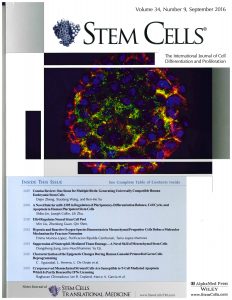 Cancer Stem Cells: Prostaglandin E2 (PGE2), is an inflammatory molecule produced by cyclo-oxygenase 2 (COX2) enzyme. PGE2 regulates growth and development and essential for survival. Both COX2 and PGE2 promotes breast cancer and induces tumor promoting micro RNA in breast cancer. We have shown that both COX-2 and PGE2 regulates cancer stem cells (CSCs). We could regulate CSC in aggressive breast tumors using COX2 inhibitor and EP4 antagonist. Breast CSCs are high on non-coding RNA content. We are investigating the roles of a specific kind of non-coding RNA called, microRNA (miRNA) in CSCs regulation. miRNAs are small non-coding RNA, regulates protein expression by inhibiting target gene expression.
Cancer Stem Cells: Prostaglandin E2 (PGE2), is an inflammatory molecule produced by cyclo-oxygenase 2 (COX2) enzyme. PGE2 regulates growth and development and essential for survival. Both COX2 and PGE2 promotes breast cancer and induces tumor promoting micro RNA in breast cancer. We have shown that both COX-2 and PGE2 regulates cancer stem cells (CSCs). We could regulate CSC in aggressive breast tumors using COX2 inhibitor and EP4 antagonist. Breast CSCs are high on non-coding RNA content. We are investigating the roles of a specific kind of non-coding RNA called, microRNA (miRNA) in CSCs regulation. miRNAs are small non-coding RNA, regulates protein expression by inhibiting target gene expression.
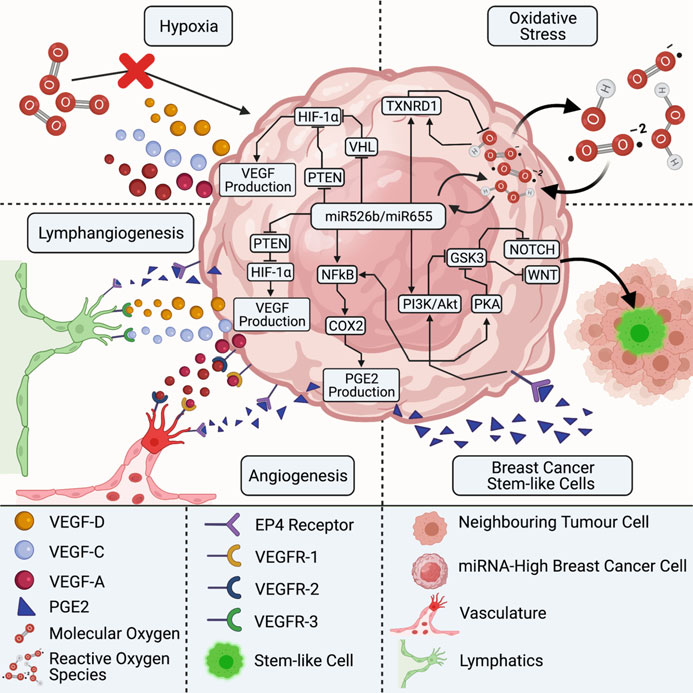 TME: We think the bidirectional communication between tumor and its microenvironment is critical to promote cancer. While miRNA transported via exosomes in the body circulation and some circulating tumor cells carrying these miRNAs might act as messenger and helps metastasis by abrogating tumor suppressor gene functions. The mechanisms of miRNAs regulating TME not clearly known. With miRNA Micro Arrays, we have identified two such miRNA (miR526b and miR655) high in COX- expression by stimulating the EP4 receptor in breast cancer. EP4 is a G-coupled receptor required for cell survival and proliferation. Micro RNA overexpression in poorly metastatic cell lines promote angiogenesis by secreting vascular factors or stimulators in the tumor microenvironment to induce the growth and migration of endothelial cells which in turn promotes angiogenesis. We are investigating these phenotypes with miRNA high cancer cells and primary HUVEC cells.
TME: We think the bidirectional communication between tumor and its microenvironment is critical to promote cancer. While miRNA transported via exosomes in the body circulation and some circulating tumor cells carrying these miRNAs might act as messenger and helps metastasis by abrogating tumor suppressor gene functions. The mechanisms of miRNAs regulating TME not clearly known. With miRNA Micro Arrays, we have identified two such miRNA (miR526b and miR655) high in COX- expression by stimulating the EP4 receptor in breast cancer. EP4 is a G-coupled receptor required for cell survival and proliferation. Micro RNA overexpression in poorly metastatic cell lines promote angiogenesis by secreting vascular factors or stimulators in the tumor microenvironment to induce the growth and migration of endothelial cells which in turn promotes angiogenesis. We are investigating these phenotypes with miRNA high cancer cells and primary HUVEC cells.
 Cell Secretome: The cell secretome is a pool of proteins secreted by cells into the extracellular space. A significant portion (~13-20%) of the human proteome consists of secretory proteins. The secretory proteins play important roles in cell migration, cell signaling, and cell-cell communication. Using Mass Spectrometry analysis in collaboration with Dr. Chen in Chemistry Department, we are investigating if any significant protein fold changes among poorly metastatic and aggressive breast cancer cells. Protein pathway analysis helps us to better understand the properties and different natures of breast cancer cells. Secretory markers have high potential to serve as biomarkers. By comparing miRNA-overexpressed tumor secretome with miRNA low cell secretome, we identified various markers which can serve as therapeutic targets.
Cell Secretome: The cell secretome is a pool of proteins secreted by cells into the extracellular space. A significant portion (~13-20%) of the human proteome consists of secretory proteins. The secretory proteins play important roles in cell migration, cell signaling, and cell-cell communication. Using Mass Spectrometry analysis in collaboration with Dr. Chen in Chemistry Department, we are investigating if any significant protein fold changes among poorly metastatic and aggressive breast cancer cells. Protein pathway analysis helps us to better understand the properties and different natures of breast cancer cells. Secretory markers have high potential to serve as biomarkers. By comparing miRNA-overexpressed tumor secretome with miRNA low cell secretome, we identified various markers which can serve as therapeutic targets.
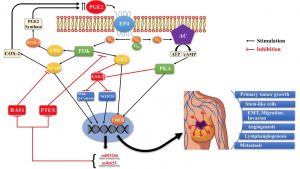 Targeting EP4: EP4 is a G-coupled receptor required for cell survival and proliferation. Inhibition of EP4 could abrogate all COX-2 induced functions including cancer stem cell reduction and miRNA downregulation. Over the decade immense research has been done on an inflammation-associated enzyme called cyclo-oxygenase-2 (COX-2), which produces PGE2 and activated its receptor EP4. This will activate VEGF, PI3K/AKT, and ERK pathways. COX-2 expressed by about half of primary human breast cancer cases drives tumour progression and spread to other tissues (metastasis) by multiple mechanisms. Recently, we discovered that COX-2 induces CSCs via EP4/PI3K/AkT/NOTCH/WNT pathways and also induces miRNA. The image is taken from Majumder et al, IJMS, 2018.
Targeting EP4: EP4 is a G-coupled receptor required for cell survival and proliferation. Inhibition of EP4 could abrogate all COX-2 induced functions including cancer stem cell reduction and miRNA downregulation. Over the decade immense research has been done on an inflammation-associated enzyme called cyclo-oxygenase-2 (COX-2), which produces PGE2 and activated its receptor EP4. This will activate VEGF, PI3K/AKT, and ERK pathways. COX-2 expressed by about half of primary human breast cancer cases drives tumour progression and spread to other tissues (metastasis) by multiple mechanisms. Recently, we discovered that COX-2 induces CSCs via EP4/PI3K/AkT/NOTCH/WNT pathways and also induces miRNA. The image is taken from Majumder et al, IJMS, 2018.
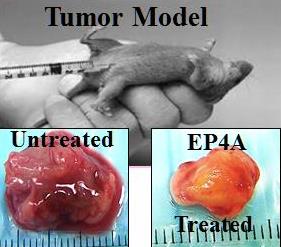 Efficacy of Drugs: We also found that drugs blocking EP4 receptor were highly effective in controlling breast cancer growth, metastasis and stem cell replication and miRNA expression in experimental animals, without hurting normal stem cells. These drugs are future candidates for human trials, in combination with traditional therapies. Images adapted from Majumder et al, Cancer Science, 2014, Stem Cells 2016.
Efficacy of Drugs: We also found that drugs blocking EP4 receptor were highly effective in controlling breast cancer growth, metastasis and stem cell replication and miRNA expression in experimental animals, without hurting normal stem cells. These drugs are future candidates for human trials, in combination with traditional therapies. Images adapted from Majumder et al, Cancer Science, 2014, Stem Cells 2016.
Angiogenesis Assay with Zebrafish model: Danio rerio, better known as zebrafish, have emerged as a popular model for studying developmental processes and human disorders. Zebr afish share a high level of genetic and physiologic homology with humans, including the brain, digestive tract, musculature, vasculature, and an innate immune system. Moreover, approximately 70 % of all human disease genes have functional homologs with the species. Their extrauterine development is rapid; the major organs of the zebrafish are fully developed by 24 hours post fertilization (HPF), and they are ready for use in larvae experiments by 3 days post fertilization (DPF). Zebrafish larvae are transparent during the early stages of life, therefore easy to observe their movement and development under the microscope. In collaboration with Dr. LeMoine we are using zebrafish to investigating the regulatory role of Prostaglandin E2 (PGE2) and miRNA in vertebrate development, mainly in the following domains: (1) evaluating growth and angiogenesis with PGE2 microinjection; further we shall conduct (2) tumor metastasis; (3) anti-tumor drug screening and (4) cancer drug-related toxicity.
afish share a high level of genetic and physiologic homology with humans, including the brain, digestive tract, musculature, vasculature, and an innate immune system. Moreover, approximately 70 % of all human disease genes have functional homologs with the species. Their extrauterine development is rapid; the major organs of the zebrafish are fully developed by 24 hours post fertilization (HPF), and they are ready for use in larvae experiments by 3 days post fertilization (DPF). Zebrafish larvae are transparent during the early stages of life, therefore easy to observe their movement and development under the microscope. In collaboration with Dr. LeMoine we are using zebrafish to investigating the regulatory role of Prostaglandin E2 (PGE2) and miRNA in vertebrate development, mainly in the following domains: (1) evaluating growth and angiogenesis with PGE2 microinjection; further we shall conduct (2) tumor metastasis; (3) anti-tumor drug screening and (4) cancer drug-related toxicity.
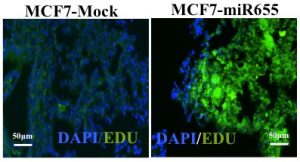 miRNA as breast cancer biomarker: We have identified two oncogenic tumor promoting miRNAs, miR526b and miR655 in human breast cancer. We have established that this two-miRNA expression promotes tumor metastasis in vivo in a mouse model (figure showing lung metastasis in NOD/SCID mouse injected with miRNA high breast tumor cells). Both miRNAs are significantly high in human breast tumor tissues compared to normal tissues (figures adapted from Majumder et al, Sci Rep 2018).
miRNA as breast cancer biomarker: We have identified two oncogenic tumor promoting miRNAs, miR526b and miR655 in human breast cancer. We have established that this two-miRNA expression promotes tumor metastasis in vivo in a mouse model (figure showing lung metastasis in NOD/SCID mouse injected with miRNA high breast tumor cells). Both miRNAs are significantly high in human breast tumor tissues compared to normal tissues (figures adapted from Majumder et al, Sci Rep 2018).
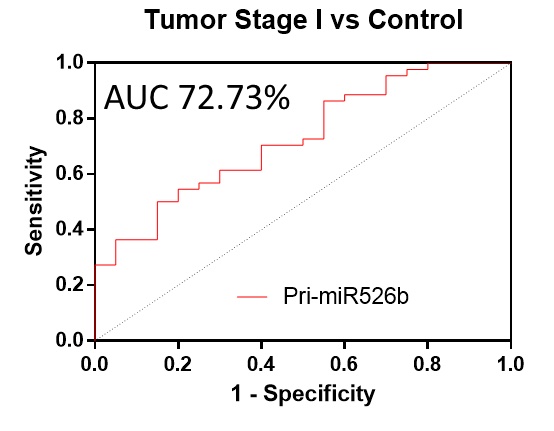 In collaboration with Dr. Lala at the University of Western Ontario and Dr. Brackstone at the London Regional Cancer Program, we have access to matched blood plasma and biopsy tissues from breast cancer patients. We discovered two pri-miRNAs, pri-miR526b and pri-miR655 showing strong potential to serve as Biomarker. Our current focus is to validate these pri-miRNAs in a large set of specimens. We shall be able to encourage population-wide screening of breast cancer for early detection. If we can detect early we can increase patient survival.
In collaboration with Dr. Lala at the University of Western Ontario and Dr. Brackstone at the London Regional Cancer Program, we have access to matched blood plasma and biopsy tissues from breast cancer patients. We discovered two pri-miRNAs, pri-miR526b and pri-miR655 showing strong potential to serve as Biomarker. Our current focus is to validate these pri-miRNAs in a large set of specimens. We shall be able to encourage population-wide screening of breast cancer for early detection. If we can detect early we can increase patient survival.
Oxidative stress and miRNA: In eukaryotes, overproduction of reactive oxygen species (ROS) causes oxidative stress, which contributes 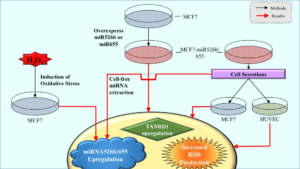 to chronic inflammation and cancer. We established that overexpression of miR526b/miR655 promotes aggressive breast cancer phenotypes directly enhances ROS and superoxide (SO) production. We also found that cell-free conditioned media contain extracellular miRNAs and treatment with these miRNA-conditioned media causes overproduction of ROS/SO in non-metastatic tumor cell MCF7 and primary cells (HUVECs). Most interestingly while cells are going through oxidative stress phases they produce miR526b/miR655 expression indicating that miRNA and OS are partners in crime, both help each other to enhance metastasis.
to chronic inflammation and cancer. We established that overexpression of miR526b/miR655 promotes aggressive breast cancer phenotypes directly enhances ROS and superoxide (SO) production. We also found that cell-free conditioned media contain extracellular miRNAs and treatment with these miRNA-conditioned media causes overproduction of ROS/SO in non-metastatic tumor cell MCF7 and primary cells (HUVECs). Most interestingly while cells are going through oxidative stress phases they produce miR526b/miR655 expression indicating that miRNA and OS are partners in crime, both help each other to enhance metastasis.
